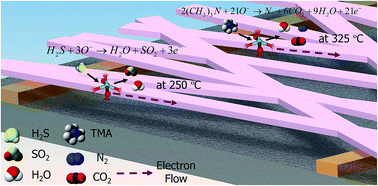Molybdenum trioxide nanopaper as a dual gas sensor for detecting trimethylamine and hydrogen sulfide†
Abstract
A free-standing, flexible, and semi-transparent MoO3 nanopaper was fabricated using ultralong MoO3 nanobelts (length ∼ 200 μm; width 200–400 nm), and its gas-sensing characteristics were investigated. The sensor exhibited high responses (resistance ratio) of 49 to 5 parts per million (ppm) hydrogen sulfide (H2S) at 250 °C and 121 to 5 ppm trimethylamine (TMA) at 325 °C with excellent gas selectivity, demonstrating its dual function for gas detection. Moreover, the sensor showed promising potential for the all-in-one detection of three representative offensive odors (TMA, H2S, and NH3) simply by tuning of the sensing temperature. This particular performance is attributed to the high chemical affinity of MoO3 to H2S and the acid–base interaction between basic TMA/NH3 and acidic MoO3. The mechanism underlying the control of gas selectivity by modulating the sensor temperature was investigated by Diffuse Reflectance Infrared Fourier Transform (DRIFT) measurements.



 Please wait while we load your content...
Please wait while we load your content...